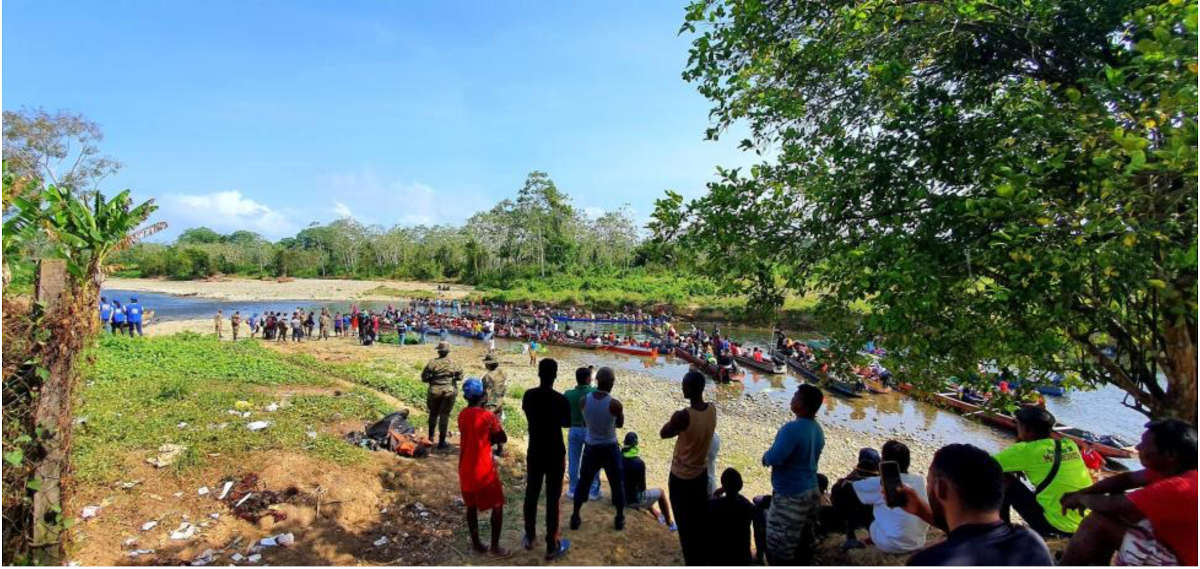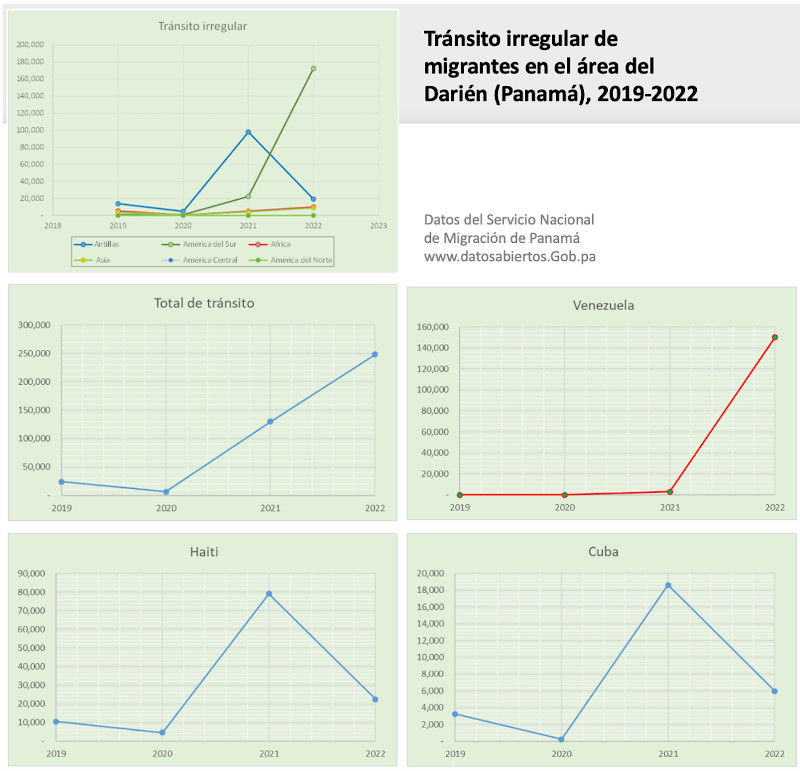In the picture
Migrants at the end of their passage through the Darien Jungle; canoes take them to reception centers in Panama [IOM/Idiam Osorio].
report AMERICAN REGIONAL SECURITY, SRA 2023 /PDF version from article
Until 2018, a few thousand people from Asia and Africa crossed the Darien, seeking to join the Central American caravans unnoticed.
° In 2021, transits soared to 130,000; in 2022, with a boom first from the West Indies and then from Venezuela, it reached 250,000 and in 2023 it may double again.
° Once the Darien Dam overflowed, the migratory wave reached the US border, making 2022 the year of greatest illegal migratory pressure in the country's history.
The Darien Gap is located in Panama and borders Colombia. The inhospitable and intricate jungle has historically made overland connection between the two countries impossible. The exhibition to diseases, the risks of wild animal life and the lack of water and possible supplies make this route extremely dangerous. Although exposed to mafia exploitation, robbery, sexual violence and even death, migrants have been making their way through this impassable passage, driven by necessity. From a previous transit of irregular migrants that annually stood at under 10,000 people, in recent years the number has skyrocketed: 133,726 in 2021 and a record 248,284 in 2022.
The serious migratory crises in several countries -singularly Haiti, Cuba and Venezuela- and the news that other migrants managed to overcome the test have multiplied the flow enormously. Once the bottleneck was broken, these migratory masses advanced through Central America to reach the border with the United States. The year 2022 was the year of greatest illegal migratory pressure in the history of the North American nation: the border services made 2.7 million apprehensions.
Developments
Until the present status, migrants from the Caribbean and South America who wanted to march to the United States avoided this route. Washington's attention was then directed to the attempt of people from other continents to use the unsuspected Darien gateway to then dilute themselves among the caravans of migrants from the Central American Northern Triangle moving towards the United States. It was a way to set foot on the American continent, in a place of very difficult surveillance, without leaving any trace of arrival. This made U.S. authorities suspect that radical Islamists from the Middle East might be using this tactic.
But things began to change due to the pressure of Haitian migration, to which other doors were being closed, and the worsening conditions in Cuba: desperate situations that led to risk everything by crossing the Darien jungle to reach the United States. If in 2018 the total number of irregular migrant transits through the Darien was 8,445, 91% of which came from Asia and Africa, in 2019 the issue rose to 23,968, of which 10,510 corresponded to Haitians and 3,276 to Cubans.
In 2020, the restrictions of mobility caused by the Covid-19 health emergency brought the numbers down to a total of 6,465, a reduction of 73%. However, the effects of the pandemic aggravated the causes that pushed people to leave their own country in search of better living conditions, which led to an increase in the migratory flow. Thus, in 2021 the Issue of transits through the Darien increased twenty-fold, reaching 133,726, most of them of people from the Antilles: 101,072 Haitians (82,952 arrived from Haiti and the rest through Chile and Brazil) and 18,600 Cubans.
In 2022, the marked growth continued, with a 90% increase, reaching a transit of 248,284 people. There was less migratory pressure from the Caribbean, but this was more than compensated for by the Venezuelan exodus: last year, 150,327 Venezuelans transited the Darien jungle, with entire families. The presence of children on such a dangerous journey has been highlighted by Unicef. So far in 2023 the flow continues to increase, this time with a large presence of Ecuadorians, whose country has experienced a sharp increase in violence and a deterioration of economic conditions. The total for this year could exceed 400,000 migrants.
In this bet on a route that Latin American migrants used to absolutely discard, social networks have been influential, transmitting advice on how to overcome the difficult test, although they also spread false information presenting the crossing as less inhumane than it really is. The Darien hashtag, for example, had been viewed almost 500,000 times on TikTok by September last year.
To cross the Darien Gap, migrants leave from Necocli in Colombia. There they embark and cross the Gulf of Urabá to the Colombian town of Acandía and then penetrate the jungle until they reach San Vicente in Darién, where the Panamanian government offers attendance to migrants. They also have temporary migrant reception stations at both borders, where data takes biometrics of the migrants and offers health and food services. They are then transported to another center near the Costa Rican border.


